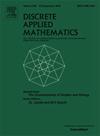图中独立隔离的界
IF 1
3区 数学
Q3 MATHEMATICS, APPLIED
引用次数: 0
摘要
图的孤立集是顶点S的集合,当S和它的邻域被移除时,只剩下孤立的顶点;隔离数是这样一个集合的最小大小。已知除了K2和C5之外的每一个连通图,隔离数最多为三分之一阶,并且这样的图确实有三个不相交的隔离集。本文考虑要求S为独立集的隔离集,并将其最小值称为独立隔离数。对于一般n阶图,独立隔离数可以任意接近于n/2,我们证明了在二部图中,顶点集可以划分为3个不相交的独立隔离集,其中独立隔离数最多为n/3;而对于3色图,独立隔离数的最大值为(n+1)/3。我们也为k色图提供了一个界。本文章由计算机程序翻译,如有差异,请以英文原文为准。
Bounds on independent isolation in graphs
An isolating set of a graph is a set of vertices such that, if and its neighborhood is removed, only isolated vertices remain; and the isolation number is the minimum size of such a set. It is known that for every connected graph apart from and , the isolation number is at most one-third the order and indeed such a graph has three disjoint isolating sets. In this paper we consider isolating sets where is required to be an independent set and call the minimum size thereof the independent isolation number. While for general graphs of order the independent isolation number can be arbitrarily close to , we show that in bipartite graphs the vertex set can be partitioned into three disjoint independent isolating sets, whence the independent isolation number is at most ; while for 3-colorable graphs the maximum value of the independent isolation number is . We also provide a bound for -colorable graphs.
求助全文
通过发布文献求助,成功后即可免费获取论文全文。
去求助
来源期刊

Discrete Applied Mathematics
数学-应用数学
CiteScore
2.30
自引率
9.10%
发文量
422
审稿时长
4.5 months
期刊介绍:
The aim of Discrete Applied Mathematics is to bring together research papers in different areas of algorithmic and applicable discrete mathematics as well as applications of combinatorial mathematics to informatics and various areas of science and technology. Contributions presented to the journal can be research papers, short notes, surveys, and possibly research problems. The "Communications" section will be devoted to the fastest possible publication of recent research results that are checked and recommended for publication by a member of the Editorial Board. The journal will also publish a limited number of book announcements as well as proceedings of conferences. These proceedings will be fully refereed and adhere to the normal standards of the journal.
Potential authors are advised to view the journal and the open calls-for-papers of special issues before submitting their manuscripts. Only high-quality, original work that is within the scope of the journal or the targeted special issue will be considered.
 求助内容:
求助内容: 应助结果提醒方式:
应助结果提醒方式:


